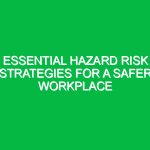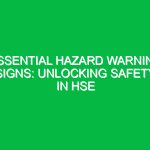Welcome Team
Good morning, everyone! Today, we are here to conduct a toolbox talk focused on a crucial aspect of our work: Working Alongside Subcontractors within the Health, Safety, and Environment (HSE) domain. As many of you know, subcontractors play an essential role in our projects, and it’s vital that we collaborate effectively to ensure a safe working environment for everyone involved. Let’s dive into why this collaboration matters and how we can achieve it.
Understanding the Role of Subcontractors
Subcontractors are specialized professionals who assist us in completing specific tasks that require expertise that our team may not possess. They might handle electrical work, plumbing, or even Safety assessments. While their skills are invaluable, Working Alongside Subcontractors requires clear communication, shared Safety protocols, and a mutual understanding of our HSE objectives.
Why Collaboration Matters
When we work alongside subcontractors, we create a unified front that enhances safety and efficiency. Here are some key reasons why collaboration is essential:
- Shared Safety Standards: Ensuring that all parties adhere to the same safety protocols minimizes risks.
- Clear Communication: Open lines of communication help clarify roles, responsibilities, and expectations.
- Enhanced Problem Solving: Collaborative efforts can lead to innovative solutions for challenges we may face on-site.
Key Safety Practices When Working with Subcontractors
To ensure everyone’s safety and the success of our projects, we must establish some Best Practices. Here are actionable steps we can take:
1. Conduct Joint Safety Meetings
Before starting any project, it’s crucial to hold a joint safety meeting with subcontractors. This meeting should cover:
- Project scope and specific safety Hazards associated with the work.
- Emergency Procedures and contact information.
- Personal protective equipment (PPE) requirements.
For example, if we’re working with an electrical subcontractor, we should discuss potential Electrical Hazards and ensure that everyone understands the necessary Precautions.
2. Develop a Unified Safety Plan
Creating a safety plan that includes both our team and subcontractors ensures that everyone is on the same page. This plan should outline:
- Specific roles and responsibilities regarding safety.
- Hazard identification and risk assessment procedures.
- Reporting protocols for incidents or near misses.
A unified safety plan fosters a culture of accountability and encourages everyone to take ownership of their safety responsibilities.
3. Regular Site Inspections
Conducting regular safety inspections helps identify potential Hazards before they cause accidents. Involve subcontractors in these inspections to ensure that:
- They are aware of the site conditions.
- They understand their responsibilities regarding safety compliance.
For instance, if we notice a stack of materials obstructing a walkway, it’s essential for both our team and subcontractors to address this hazard promptly.
Identifying and Managing Hazards
When Working Alongside Subcontractors, we must be vigilant about identifying potential hazards. Here are common risks associated with subcontractor work:
- Equipment Safety: Improper use of machinery can lead to accidents. Ensure that everyone is trained on the equipment they will be using.
- Environmental Risks: Subcontractors may work with hazardous materials. It’s crucial to follow proper storage and disposal protocols.
- Worksite Conditions: Slips, trips, and falls are common hazards. Keep work areas clean and organized.
Real-Life Example
Let’s consider a scenario where we have a subcontractor working on a plumbing installation. If the subcontractor neglects to secure loose pipes, it could lead to water leaks or even injuries. By conducting joint safety meetings and regular inspections, we can identify these risks before they escalate.
Compliance with Regulations and Standards
Compliance with relevant regulations and standards is non-negotiable when Working Alongside Subcontractors. Familiarize yourself with key regulations such as:
- OSHA standards for Workplace Safety.
- Local building codes.
- Environmental protection guidelines.
Understanding these regulations not only keeps us compliant but also protects our employees and subcontractors. Non-compliance can lead to costly fines and, more importantly, jeopardize the safety of our team.
Open Communication: The Key to Success
Establishing an environment of open communication is critical. Here are some practical steps to improve communication:
- Daily Briefings: Begin each day with a quick briefing to discuss the day’s objectives and any potential hazards.
- Feedback Mechanism: Encourage subcontractors to voice any concerns or suggestions regarding safety practices.
- Conflict Resolution Strategies: Address any conflicts or misunderstandings promptly to maintain a positive working relationship.
For instance, if a subcontractor feels uncomfortable with a specific task due to safety concerns, it is vital to address these concerns immediately rather than allowing them to fester.
Encouraging Team Engagement
Engagement is essential for a safe workplace. Here’s how we can encourage our team and subcontractors to be proactive about safety:
- Incentive Programs: Implement programs that reward teams for maintaining a safe work environment.
- Safety Committees: Form committees that include both our employees and subcontractors to discuss safety improvements.
- Training Opportunities: Provide Training sessions that emphasize the importance of working safely together.
Questions for Discussion
To foster engagement, let’s take a moment to discuss:
- What challenges have you faced when working with subcontractors regarding safety?
- How can we improve our communication with subcontractors to ensure safety?
Conclusion
In summary, Working Alongside Subcontractors is a vital part of our operations that requires a strong commitment to safety, communication, and compliance. By conducting effective Toolbox Talks, establishing clear safety protocols, and fostering collaboration, we can ensure a safer workplace for everyone. Thank you all for your attention and your ongoing commitment to maintaining a safe working environment. Let’s work together to make our projects successful and safe!


